VARIOUS OF PLASTIC PROCESSING TECHNIQUE
Plastics are mainly organic polymers of high molecular mass, but they sometimes contain other substances as well. Plastics are usually synthetic, most commonly derived from petrochemicals, but many are partially natural. Plastics are usually classified by their chemical structure of the polymer’s backbone and side chains. Some important groups in these classifications are the acrylics, polyesters, silicones, polyurethanes, and halogenated plastics. There are a variety of methods used to process plastic. Each method has its advantages and disadvantages and are better suited for specific applications. There are various plastic processing techniques are detailed.
Below various methods are used to processing:
- Extrusion – Calendaring – Injection Moulding – Rotational Moulding
- Compression Moulding – Blow Moulding – Thermoforming
- Pultrusion
- Extrusion:
Plastics extrusion is a high volume manufacturing process in which raw plastic material is melted and formed into a continuous profile. The process of extrusion is usually used to make products such as film, continuous sheeting, tubes, profile shapes, rods, coat wire, filaments, cords, and cables. As with injection molding, dry plastic material or compound material is placed into a hopper and feed into a long heating chamber by feeder. At the chamber have three zone. (i.e Feeder zone, Melting Zone & Processing Zone all zones are well connected with heaters), The chamber has form cylinder with contained flighted screw. however, the material is forced out of a small opening or a die in the shape of the desired finished product. As the plastic exits the die, At the same time puller has been pulling the product and the product may be immersed in water to help it cool for good strength and sharpening.
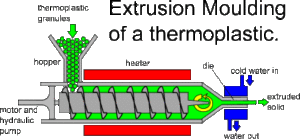
- Calendaring:
Calendering is a continuous process which works in much the same way as an old-fashioned clothes twist. For plastics, there are usually four heated rollers of different sizes rotating at slightly different speeds. The material is fed into these rollers, heated and melted, then shaped into a sheet or film. This is then cooled and rolled up. The sheets can be mono-oriented during this process. The most commonly winder has there to rolling the roll or puller has there to pull the sheet from cooled roller and cut in to required dimension.
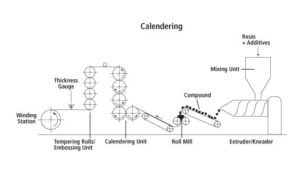
- Injection Moulding:
Injection molding is a manufacturing process for producing parts by injecting material into a mold. The main method used for processing plastic is injection molding. With this process, the plastic granules is placed into a hopper. The hopper then feeds the plastic granules into a heated injection unit, where it is pushed through a long chamber with a reciprocating screw. Here, it is softened to a fluid state. A nozzle is located at the end of the chamber. The fluid plastic is forced through the nozzle into a cold, closed mold. The halves of the mold are held shut with a system of clamps (i.e Core & Cavity, Always Core is clamped in to cavity). When the plastic is cooled and solidified, the halves open and the finished product is ejected from the press. Finally workers are seated there to cut off and finish the extra flash material from finish product.
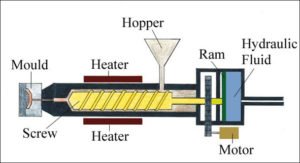
- Rotational Moulding:
Rotational molding is an extremely popular and well-used process for producing items that are usually hollow. The mould is closed and then twisted both vertically and horizontally and moved into an oven. As the powder starts to melt and the mould continues rotating, it is flung onto the walls of the mould by centrifugal force where it forms a skin. After a fixed period, the mould is removed from the oven and allowed to cool carefully to avoid the product shrinking or warping. It’s most often used for very large articles which are usually made in small quantities.
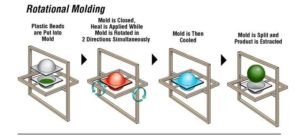
- Compression Moulding:
Compression moulding is the most common process used with thermosetting materials and is usually not used for thermoplastics. In thermoplastic may be used to making small sample pieces. With this process, the material is squeezed into its desired shape with the help of pressure and heat. Plastic moulding powder and other materials are added to the mix in order to create special qualities or to strengthen the final product. When the mould is closed and heated, the material goes through a chemical change that causes it to harden into its desired shape. The amount temperature, amount of pressure, and length of time utilized during the process depends on the desired outcome.
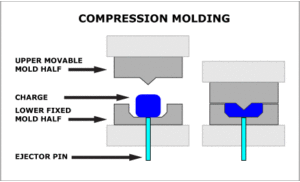
- Blow Moulding:
Blow Moulding process is mainly used when the plastic product that needs to be created should be hollow. A molten tube is created with blow moulding by using compressed air, which blows up the tube and forces it to conform to the chilled mould. Variations of blow moulding include injection, injection-stretch, and extrusion blow moulding.

- Thermoforming:
Thermoforming is a manufacturing process where a plastic sheet is heated to a bendable forming temperature, formed to a specific part shape in a mould, and trimmed to create a usable product. The sheet, or film when referring to thinner gauges and certain material types, is heated in an oven to a high-enough temperature that it can be stretched into or onto a mould and cooled to a finished shape. Similar to a injection moulding where it has contained core and cavity shaping metal structures.
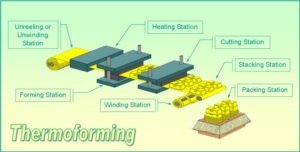
- Pultrusion:
Pultrusion is similar to extrusion in that it produces continuous cross-sectional profiles. While extrusion relies on press to push unreinforced thermoplastic materials through a short die, pultrusion pulls a variety of reinforced fibers, wetted by thermosetting and/or some thermoplastic resins, through a heated die. Polymerization of the resin occurs as the wetted fibers pass through the die, forming a continuous, rigid profile corresponding to the orifice shape.
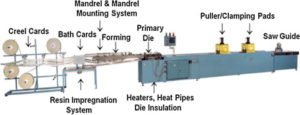




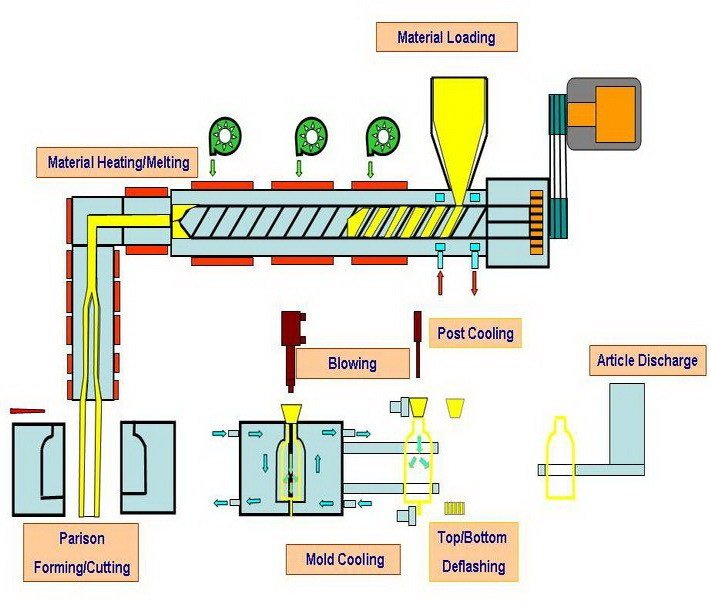
[…] Polymer academy: http://polymeracademy.com/plastic-processing-techniques/ […]